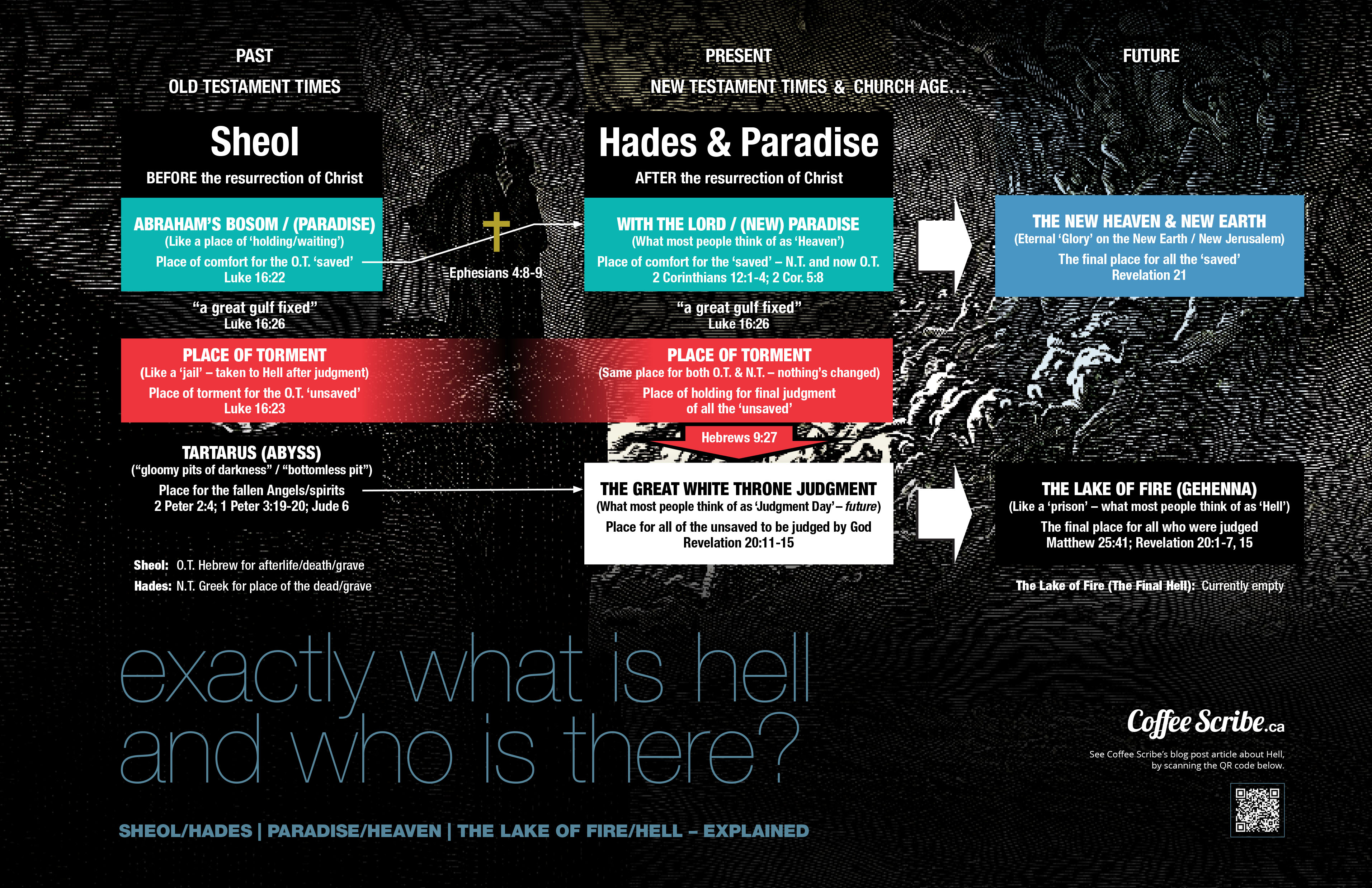What is Hell and Who is There?
Video credit: Daniel Maritz of DLM Christian Lifestyle
Exactly What is Hell and Who is There?
SHEOL/HADES: THE PRESENT HELL
What man can live and never see death? Who can deliver his soul from the power of Sheol? Selah”
– Psalm 89:48 | English Standard Version (ESV)
Hell is for real
The doctrine about Hell has fallen out of favor among many today
Hell is what Hell is because God is Who God is
A few facts about Hell
- Jesus spoke about Hell more than anything else in Scripture
- Hell shows us the true extent of God’s love in saving us in relation to the number one question people ask: “How can a ‘loving’ God send good people to Hell?” But the real question should be: “Why did a loving God do everything He could do in order to keep people from ever having to go to Hell in the first place?” The Bible says that God sent His only Son to literally take our place of punishment for what our own sins actually deserve
- People are eternal and the Biblical, Christian belief is that human beings were created to live forever. If one is going to live forever, then perhaps our bad temper or our jealousy would gradually get worse—so gradual that the increase of it in 70 years would not even be noticeable—but would be absolute Hell in a million years; In fact, if the Bible is true, then Hell is precisely correct for what that would really be if we were to be left to live that long unto ourselves
- God takes such love and interest in us as a loving Father, that He does not wish that anyone should perish:
16 For God so loved the world, that he gave his only begotten Son, that whosoever believeth in him should not perish, but have everlasting life. 17 For God sent not his Son into the world to condemn the world; but that the world through him might be saved.”
John 3:16-17 | King James Version (KJV)
God means business and takes sin seriously
People speak so superficially about “seeing God,” as if seeing God face-to-face would be some kind of warm and fuzzy experience. But the Bible explains that God’s holiness and perfections are so complete that if anyone were to see him, he would die (Ex. 33:20). Even the slightest sin in his presence leads to immediate annihilation. When Isaiah, the prophet of God, saw God upon his throne, he fell upon his face, terrified and sure that he was about to die (Is. 6:5).
The doctrine of Hell has fallen out of favor among many. But it’s there for a reason. God tells us about Hell to demonstrate to us the magnitude of his holiness. Hell is what Hell is because the holiness of God is what it is. Hell is not one degree hotter than our sin demands that it be. Hell should make our mouths stand agape at the righteous and just holiness of God. It should make us tremble before his majesty and grandeur.
Ironically, in doing away with Hell as many have done, you do away with the very resources that show God’s justice. When a person goes through rape or child abuse, she needs to know that there is a God of such holiness and beauty that His reign can tolerate no evil.
Hell is what Hell is because God is a just and righteous Judge
Imagine you’re a judge. Your job is to uphold and execute the law. It’s the only standard you must adhere to, and you must do it unflinchingly. One day a man stands before you—a vile, wicked murderer. The evidence against him is ironclad. There’s no doubt about his guilt—he openly admits it. He confesses what he did and says he’s very sorry. Then he asks you to forgive him. And in spite of what the law says, in spite of your responsibility to dispatch justice, you grant him complete forgiveness and let him walk free. We’d certainly be horrified if human judges operated that way.
But that’s exactly what our Judge has done. In spite of the clear standard of His law, and in spite of the overwhelming evidence of our sin and corruption, He sweeps aside our crimes, washes away our guilt, and sets us free from the due penalty of our sin. How can He do that and uphold His own holy law?
So, the just God of the universe had to punish sin justly—He had to pour out the full penalty on His Son to grant forgiveness to His elect people. And His justice demands that every sin that has ever been committed, by every person who has ever lived, will be punished—either in the eternal torment of Hell or on Christ at the cross. So with that said…
Exactly What is Hell and Who is There?
There is NO ONE in Hell at this present time
SHEOL/HADES (“HELL”)
There seems to be some confusion about what Hell is and who will go there because of the way the Hebrew word “Sheol” and the Greek word “Hades” have been translated in our English Bibles.
A proper understanding of what the Bible teaches about Hell, Sheol, Hades, and the Grave dispels confusion over what happens to the soul at the time of physical death and guards against being led astray by those teaching the false doctrines of soul-sleep, eradication of the soul, the universal reconciliation of mankind, the annihilation of the lost, and purgatory. All of these erroneous doctrines are of Satan, used of him to dishearten believers and blind the lost to the reality of the cost of spreading the Gospel of Jesus Christ. Our thinking, and therefore our life on a day-to-day basis is influenced by what we believe. While some of the false doctrines mentioned above are diametrically opposed to each other, they still have one thing in common—they subvert the truth of the immortality of the soul.
Then who goes to Hell?
There is no one in Hell at this present time… Hell is the same as the Lake of Fire. The FIRST to go there will be the Beast (the Antichrist) and the False Prophet. They will go there BEFORE the Thousand-year Reign of Christ; then Satan who is the devil will go there AFTER the Thousand-year Reign of Christ once the Millennium period ends and the start of the New Heaven and New Earth begins. After this, the wicked/unbelievers who are currently in Hades (the abode of the dead, also known as the “intermediate state” of the dead), will follow them, after they are judged at the Great White Throne Judgement, and then “death and Hades will be cast into the Lake of Fire.”

Poster Download: To download a high-resolution PDF (print or screen) version of the jpg poster above, click or select the turquoise button below to get your own copy!
(Once you’re on the poster page, press or select ‘download’ from that window to save a copy to your phone, tablet or computer.)
Breaking it all down…
HELL, SHEOL, HADES, PARADISE, THE GRAVE & THE LAKE OF FIRE
Sheol or the pit (Hebrew) / Hades (Greek)
- Sheol and Hades are both one-and-the-same place and it is what most people think of when they think of Hell
- It denotes the abode of the dead; the pit; the grave; an interim location for the dead; the underworld of the dead for departed spirits
- It will eventually be thrown into “Hell” which is actually “the Lake of Fire”
- There are two separate parts to Sheol/Hades with an unbridgeable spatial chasm which separates it
Sheol/Hades
Hades is the New Testament (NT) equivalent of the Old Testament (OT) word Sheol. The Greek and Hebrew words speak of the same place, the present Hell. However, this is problematic because Sheol has been translated “Grave” as often as it has “Hell” and some have mistakenly taught that Sheol and Hades are only references to the grave rather than Hell. This erroneous teaching leads to the denial of the existence of an immediate or present Hell. The false doctrine of soul-sleep, and other ideas that teach the unconscious state of the dead between death and resurrection, spring from this error.
Abraham’s Bosom (Sheol)
From the Old Testament: Part 1 – of Sheol/Hades
- A place of comfort where the righteous dead await Judgment Day (Luke 16:22-25)
- Jonah was there for three days
- The parable of Lazarus and the rich man occurs here
Jonah
When the Lord Jesus said that “as Jonah was three days and three nights in the whale’s belly; so shall the Son of Man be three days and three nights in the heart of the earth” (Matt. 12:40), He was saying that He would spend the time between His death and resurrection in Sheol/Hades. We know from Psalm 16:10 and Acts 2:25-32 that the Lord’s soul, which was made an offering for sin (Isa. 53:10), was in Sheol/Hades. It is important to note that Jesus did NOT go to Hell as the judgment for our sins was paid by Christ on the cross and not by being tortured in Hell as a sinner. And once again, Sheol/Hades is not Hell.
The rich man and Abraham
The story of the rich man and Lazarus that is found in Luke 16:19- 31 gives us the record of a remarkable conversation that took place in Hades between the rich man and Abraham. Obviously, these two men could not have had this conversation at all if Sheol/Hades is only a place where dead bodies are buried. First, there could be no communication between lifeless, decaying corpses and second, Abraham’s body, which was buried in the cave of Machpelah over 1,800 years earlier, had long since decayed. Also, the rich man’s body, regardless of whether it had decayed or not, would not have been buried in the burial cave of Abraham. From the context, it is obvious that these men were in the place of departed souls rather than a burial place.
Hades and Tartarus (the Greek word for Hell)
From the Old Testament: Part 2 – of Sheol/Tartarus
- Tartarus is where “the angels that sinned” from the great flood are awaiting judgment (2 Peter 2:4)
- This is the same place where Christ rose from the dead, taking the saints who were in “Abraham’s Bosom” to Heaven (Paradise), thus He took “captivity captive” (Eph. 4:8-10)
- Christ went “into the lower parts of the earth” between His death and resurrection to proclaim His victory over death to certain fallen angels who sinned and are now confined there (Eph. 4:9)
- Those who have rejected Christ and are in the temporary abode of the dead in Hades/Sheol have the Lake of Fire as their final destination—which is the “final Hell”
Tartarus as used by the Apostle Paul as described in the OT
The Apostle Peter used the word “Tartarus” in reference to “the angels that sinned” that God delivered to Sheol/Hades to await judgment (2 Peter 2:4). This word, which is translated “Hell” in the King James Version (KJV) of the Bible, was used in Greek mythology to refer to the place of punishment for the most wicked. It is not clear if Peter was using this word in reference to Sheol/Hades in a general way or if he was referring to a specific compartment of Sheol/Hades where a certain class of fallen angels is confined awaiting final judgment. Either way, this passage teaches that there is a place of confinement in which a particular group of beings is being held until the time of their judgment. This is consistent with the overall Biblical teaching about the existence and purpose of Sheol/Hades.
6 And the angels which kept not their first estate, but left their own habitation, he hath reserved in everlasting chains under darkness unto the judgment of the great day.”
Jude 1:6 | (KJV)
Jude here possibly refers to a group of 200 angels who descended upon Mt. Hermon and took an oath between themselves, to defile humanity; perhaps as part of Satan’s attempt to foil God’s plan of redemption.
They agreed to intermingle with women which resulted in the Nephilim. The Hebrew word nefilim is sometimes directly translated as “giants” or taken to mean “the fallen ones” (from the Hebrew naphal, “to fall”), but the identity of the Nephilim is debated by scholars. The Nephilim are possibly those being referred to as the “mighty men of renown” mentioned in Genesis 6. God put enmity between them and they set themselves against each other until they were all dead. All the Greek “gods” and the Titans were actually these Nephilim.
Additionally, the Apostle Peter mentioned Tartarus as in the context of condemning false teachers. Those who secretly introduce heresy into the church will suffer a fate similar to that of the angels who sinned—they will end up in Tartarus. The Lord does not tolerate those who lead His children astray (Matt. 18:6).
Paradise
From the New Testament
- The word “Paradise” is used as a synonym for Heaven (2 Cor. 12:3–4; Rev. 2:7)
- Today, in the time of death all believer’s souls go to Paradise in Heaven to await the time of resurrection, where their soul is reunited with their glorified body
- This is the place where the repentant thief at the time of the crucifixion would join Christ (Luke 23:42-43)
- Death has to do with the body, whereas Sheol/Hades, Abraham’s Bosom/Paradise all have to do with the soul
Paradise then and now
While Paradise is not now a part of Sheol/Hades it will be mentioned here because it was located in Sheol/Hades at one time. Before the death, burial, and resurrection of Jesus Christ, everybody who died went to Sheol/Hades, which was at that time divided into at least two compartments. One was a place of torment while the other was a place of blessing, which was referred to as “Abraham’s Bosom” (Luke 16:22-25) as already mentioned earlier. Also, Tartarus may be a specific place in Sheol/Hades as well.
This Paradise that was moved to Heaven is confirmed to us by the Apostle Paul who speaks of a man who was “caught up into Paradise” where he “heard unspeakable words” (2 Cor. 12:3,4). With Jesus Christ’s work complete, the believers who had been confined to Sheol/Hades were now taken to Heaven to wait in God’s presence until the time of their resurrection to enter His Kingdom on Earth.
The Grave
The grave is a place where the physical remains of those who have died are deposited. It can be a hole in the ground, a cave, or a specially prepared vault or other place used for interment. The soul and spirit having departed the body at death, there is no consciousness of life in the grave. It is a place of corruption that serves to point out man’s need of a Savior. The soul of man lives on after physical death and will always remain in a conscious state of being. The unsaved go to Sheol/Hades to await their resurrection unto condemnation while the redeemed go to Heaven to await their resurrection unto life (see John 5:25-29).
“Hell”
More accurately known as “the Lake of Fire”
- Hell (an Anglo-Saxon term) sometimes referred to as “Gehenna”—like Jerusalem’s burning refuse dump—which denotes burning fire and a place of final judgment
- The “second death” after final judgment day (Rev. 21:8)
- No one is in Hell at this present time; the first residents will be the Beast (Antichrist) and the False Prophet (at the end of the Tribulation) (Rev. 19:19-20)
- Then at the end of the Millennial Kingdom, Satan (the devil), Death and Hades will be cast into the Lake of Fire (Rev. 20:10)
- The unsaved dead will be raised and judged at the Great White Throne Judgement and cast there too (Rev. 20:11-15)
When a person chooses against God and, therefore, de facto chooses Hell, that person who rejects God does not know the real horrors of Hell. This may be because they do not believe Hell exists, or it may be because they have convinced themselves that it would be tolerably preferable to Heaven. But whatever they believe or do not believe—when one chooses against God, they have in fact chosen Hell.
The Lake of Fire
The Final Hell
The Lake of Fire, or Hell, is a literal place of everlasting fire that was originally created by God as a place of punishment for Satan (Matt. 25:41). The Watchers and the Rephaim are bound in chains and will eventually join him there too. Because it is referred to as the place of “outer darkness” (Matt. 8:12; 25:30), we believe that it is most probably located at the farthest reaches of the creation. Hell is sometimes called “Gehenna” which is described in Scripture as a “furnace of fire” (Matt. 13:42); “everlasting punishment” (Matt. 25:46); “the mist [gloom] of darkness” (2 Peter 2:17); the “hurt of the second death” (Rev. 2:11; 20:6,14; 21:8); “a lake of fire burning with brimstone” (Rev. 19:20; 20:10; 21:8) of which the graphic depictions of fire comes from.
While there is no one in the Lake of Fire at this time, it will one day hold a vast multitude. The first residents of this place of righteous retribution will be the Beast (Antichrist) and the False Prophet who, at the end of the Tribulation, will be “cast alive into a lake burning with brimstone” (Rev. 19:19-20). Joining them will be the unsaved of the nations who survive the Tribulation (Matt. 25:31-32,41-46). Also, at Jesus Christ’s return to earth, the rebel Israelites, i.e. unbelieving Jews, who survive the Tribulation, will be denied entrance into the Millennial Kingdom, no doubt to join their Gentile counterparts in the “place of everlasting fire”(Ezek. 20:33-38; Matt. 7:21-23; Matt. 24:29-31,45-51). Then, at the end of the Millennial Kingdom of Jesus Christ, Satan will be “cast into the lake of fire and brimstone, where the beast and the false prophet are, and shall be tormented day and night forever and ever” (Rev. 20:10). And finally, the unsaved dead of all ages will be raised and judged at the Great White Throne by Jesus Christ and then cast into the Lake of Fire (see Rev. 20:11-15).
How Not to go to Hell
A truth beyond belief
The writer of Hebrews says, “For we do not have a high priest who cannot sympathize with our weaknesses, but One who has been tempted in all things as we are, yet without sin” (Heb. 4:15). Christ had to live a complete life, fulfilling all righteousness, so it could one day be credited to us. The comprehensive nature of God’s reconciliation is staggering. When God looked at the cross, He saw us; when He looks at us, He sees His Son. Our Lord did not just take on the punishment of our sins—He lived a holy, blameless life credited to us by faith. And we now stand before God fully reconciled to Him, cloaked in the righteousness of our Jesus the Redeemer.
Accept Jesus
The Word of God emphasizes God cares, and God will not allow anybody to go to Hell without a chance. There is no need to fear Hell or to try to explain away Hell if one has truly repented of his sin and has accepted Jesus into his life as Savior and Lord. God forgives sin and it is by Jesus that God’s forgiveness is made on your behalf.
That is why Jesus died on the cross in our place of judgment, bearing our sins and the penalty of our sins Himself instead of us. This makes it possible for a holy God to forgive us of our sins and to save us from the everlasting penalty and consequences of our sin. Jesus’ sacrifice on the cross satisfied God’s wrath of sin in place of God’s wrath falling on us. His blood was the payment for our sin debt, paying the penalty that should have been ours to pay—but in Christ, God paid it Himself instead.
If one has not repented and trusted in Jesus and in His shed blood for the forgiveness of sin, he has just cause to be afraid of Hell. If one will not have mercy, he must have justice; if he will not have pardon, he must have punishment; if he will not have forgiveness (and all of these good things are offered to us in and through Christ alone), he must have condemnation; if one will not have Heaven as God’s free gift through Jesus Christ to all who repent and trust in Him, he must have Hell.
And so it will be
“10 and the devil who had deceived them was thrown into the lake of fire and sulfur where the beast and the false prophet were, and they will be tormented day and night forever and ever.”
Revelation 20:10 | (ESV)
“14Then Death and Hades were thrown into the lake of fire. This is the second death, the lake of fire. 15 And if anyone’s name was not found written in the book of life, he was thrown into the lake of fire.”
Revelation 20:14-15 | (ESV)“The sinner’s problem with Hell is not the absence of God, but the presence of God.”
– Dr. R.C. Sproul“God doesn’t ‘send’ people to Hell—He just honors their choice.” – Unknown
“God certainly ‘does send’ people to Hell. He does pass sentence, and he does execute perfect justice; indeed, worse than that—God does not just ‘send,’ he ‘throws!’”
– Coffee Scribe
Download your own printable version of this entire web article, in a PDF format for easily sharing and emailing to friends and family.
Note: This is the Article and not the Poster above! This print version of our Article is in an Adobe Acrobat PDF format as an 8.5″ x 11″ multi-paged, letter-sized document. Enjoy!
Did Jesus go to hell between His death and resurrection? What happened to Jesus after he died? Did Jesus preach in hell? These are all common question about what happened to Jesus after the crucifixion. In this video, Pastor Nelson goes to the Bible to answer those questions about, where was Jesus for the three days between His death and resurrection.





This Post Has 0 Comments